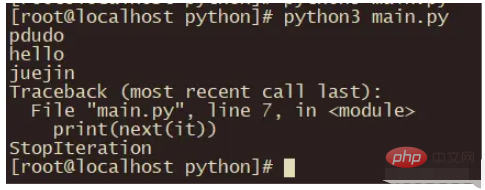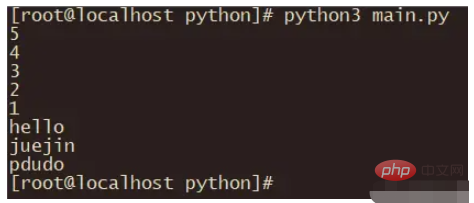How to create an iterator in Python?
What is an iterator
What ispythonIterator? Let’s take the simplest example:
list1 = ["pdudo","juejin","hello"]
tuple1 = ("pdudo","juejin","hello")
dict1 = {"name":"pdudo"}
for i in list1:
print(i)
for i in tuple1:
print(i)
for i in dict1:
print(i)This is the python iterator. Okay, that’s it, let’s do it manually.
Yes, using the for...in method, the bottom layer uses iterators. When you wrote before, you were never curious about why you traverse different All data types can be used for...in is universal?
My brother, I am the same. I have never thought about why it can be written like this. We have already talked about the iterator syntax. Next, let’s peel off the veil of iterators.
Why an iterator is needed
As long as it meets the python iterator conditions, you can use for...in to traverse elements, that is: Use the same code to traverse different data containers. I think this is the root cause.
If the above description is not clear, we can use c and python to traverse the array and string, and we will have a clear understanding.

The above code is c language traversing array"pdudo","hello","juejin"and stringpdudohellojuejin, we need to write the critical value of the traversal condition ourselves.
And how to use python to write it? Let’s take a look.
list1 = ["pdudo","hello","juejin"]
char1 = "pdudohellojuejin"
for v in list1:
print(v)
for c in char1:
print(c)You only need to define the array and string, and then use for...in and you are done.
I think the above example is enough to prove why you should use iterators, because it’s really fun.
How iterators work
After going through the first two paragraphs, I guess you must want to know how iterators work, right? Now it's here.
When using the for...in statement, it will call the inter() object, which will return an iterator object. The object also defines the __next__() method, which returns one container element at a time. When no more elements can be returned, a StopIteration exception will be thrown to indicate for Terminate the loop.
Still don’t understand? It doesn’t matter, let’s write another case to illustrate.
list1 = ["pdudo","hello","juejin"] it = iter(list1) print(next(it)) print(next(it)) print(next(it)) print(next(it))
The above code defines a list whose values are: "pdudo", "hello", "juejin", and then calls the iter method, which will return an iterator, and then The next method is called to return the next element, but the length of the list we defined is 3, and the next method is called 4 times. It can be seen that the last time an exception will be thrown.
After we execute, the effect is as follows:

It can be seen that it is consistent with our above guess, in the for...in statement , the inter() container object is also called, and __next__ is used to return subsequent iterable objects, and so on, until an exception StopIteration is encountered and the loop ends.
Okay, do you know how iterators work? So, let’s throw another question to see if you can answer it? How to determine if a data type can be iterated?
How to create an iterator
We have learned how to use iterators and know how iterators work. This paragraph will introduce how to create an iterator. Before looking at this , let’s think about a question, will the following code report an error?
a = 9527
for i in a:
print(i)We use for...in to traverse a int type of data.
The above code will of course report an error, which leads to our knowledge point: What kind of data type can be iterated?
is like this. Whether it can be iterated depends on whether the method has a __iter__ method.
You can look at the following example. We have customized an iterator for flashback output data.
#!/bin/env python
class flashBack:
def __init__(self,list1):
self.data = list1
self.index = len(list1)-1
def __iter__(self):
return self
def __next__(self):
if self.index < 0:
raise StopIteration
val = self.data[self.index]
self.index = self.index - 1
return val
def main():
list1 = [1,2,3,4,5]
tuble1 = ("pdudo","juejin","hello")
for i in flashBack(list1):
print(i)
for i in flashBack(tuble1):
print(i)
if __name__ == '__main__':
main()After execution, the result is:

It can be seen that to create an iterator, at least the __iter__ method and are required __next__ method.
Okay, with this basic case, let’s write a linked list?
#!/bin/env python
class Node:
def __init__(self,val):
self.val = val
self.nextNode = None
class Lists:
def __init__(self,currentNodes):
self.currentNode = currentNodes
def __iter__(self):
return self
def __next__(self):
if self.currentNode is None:
raise StopIteration
v = self.currentNode.val
self.currentNode = self.currentNode.nextNode
return v
def main() :
node1 = Node(1)
node2 = Node(2)
node3 = Node(3)
node1.nextNode = node2
node2.nextNode = node3
for i in Lists(node1):
print(i)
if __name__ == '__main__':
main()As shown in the above code, we first create the node Node, which has 2 values, val is the recorded value, and nextNode is the record The pointer to the next Node, and then defines the class Lists. When calling, you need to pass in a Node, which will currentNodes Record the current Node. Focus on __next__. When the current node is empty, StopIteration is returned to inform for that the iterator is over. Otherwise, take out the val of the current node and return it, and slide it down to the next node.
The above code, after running, the results are as follows:

The above is the detailed content of How to create an iterator in Python?. For more information, please follow other related articles on the PHP Chinese website!

Hot AI Tools

Undresser.AI Undress
AI-powered app for creating realistic nude photos

AI Clothes Remover
Online AI tool for removing clothes from photos.

Undress AI Tool
Undress images for free

Clothoff.io
AI clothes remover

Video Face Swap
Swap faces in any video effortlessly with our completely free AI face swap tool!

Hot Article

Hot Tools

Notepad++7.3.1
Easy-to-use and free code editor

SublimeText3 Chinese version
Chinese version, very easy to use

Zend Studio 13.0.1
Powerful PHP integrated development environment

Dreamweaver CS6
Visual web development tools

SublimeText3 Mac version
God-level code editing software (SublimeText3)

Hot Topics
 PHP and Python: Different Paradigms Explained
Apr 18, 2025 am 12:26 AM
PHP and Python: Different Paradigms Explained
Apr 18, 2025 am 12:26 AM
PHP is mainly procedural programming, but also supports object-oriented programming (OOP); Python supports a variety of paradigms, including OOP, functional and procedural programming. PHP is suitable for web development, and Python is suitable for a variety of applications such as data analysis and machine learning.
 Choosing Between PHP and Python: A Guide
Apr 18, 2025 am 12:24 AM
Choosing Between PHP and Python: A Guide
Apr 18, 2025 am 12:24 AM
PHP is suitable for web development and rapid prototyping, and Python is suitable for data science and machine learning. 1.PHP is used for dynamic web development, with simple syntax and suitable for rapid development. 2. Python has concise syntax, is suitable for multiple fields, and has a strong library ecosystem.
 Python vs. JavaScript: The Learning Curve and Ease of Use
Apr 16, 2025 am 12:12 AM
Python vs. JavaScript: The Learning Curve and Ease of Use
Apr 16, 2025 am 12:12 AM
Python is more suitable for beginners, with a smooth learning curve and concise syntax; JavaScript is suitable for front-end development, with a steep learning curve and flexible syntax. 1. Python syntax is intuitive and suitable for data science and back-end development. 2. JavaScript is flexible and widely used in front-end and server-side programming.
 PHP and Python: A Deep Dive into Their History
Apr 18, 2025 am 12:25 AM
PHP and Python: A Deep Dive into Their History
Apr 18, 2025 am 12:25 AM
PHP originated in 1994 and was developed by RasmusLerdorf. It was originally used to track website visitors and gradually evolved into a server-side scripting language and was widely used in web development. Python was developed by Guidovan Rossum in the late 1980s and was first released in 1991. It emphasizes code readability and simplicity, and is suitable for scientific computing, data analysis and other fields.
 Can vs code run in Windows 8
Apr 15, 2025 pm 07:24 PM
Can vs code run in Windows 8
Apr 15, 2025 pm 07:24 PM
VS Code can run on Windows 8, but the experience may not be great. First make sure the system has been updated to the latest patch, then download the VS Code installation package that matches the system architecture and install it as prompted. After installation, be aware that some extensions may be incompatible with Windows 8 and need to look for alternative extensions or use newer Windows systems in a virtual machine. Install the necessary extensions to check whether they work properly. Although VS Code is feasible on Windows 8, it is recommended to upgrade to a newer Windows system for a better development experience and security.
 Can visual studio code be used in python
Apr 15, 2025 pm 08:18 PM
Can visual studio code be used in python
Apr 15, 2025 pm 08:18 PM
VS Code can be used to write Python and provides many features that make it an ideal tool for developing Python applications. It allows users to: install Python extensions to get functions such as code completion, syntax highlighting, and debugging. Use the debugger to track code step by step, find and fix errors. Integrate Git for version control. Use code formatting tools to maintain code consistency. Use the Linting tool to spot potential problems ahead of time.
 How to run python with notepad
Apr 16, 2025 pm 07:33 PM
How to run python with notepad
Apr 16, 2025 pm 07:33 PM
Running Python code in Notepad requires the Python executable and NppExec plug-in to be installed. After installing Python and adding PATH to it, configure the command "python" and the parameter "{CURRENT_DIRECTORY}{FILE_NAME}" in the NppExec plug-in to run Python code in Notepad through the shortcut key "F6".
 Is the vscode extension malicious?
Apr 15, 2025 pm 07:57 PM
Is the vscode extension malicious?
Apr 15, 2025 pm 07:57 PM
VS Code extensions pose malicious risks, such as hiding malicious code, exploiting vulnerabilities, and masturbating as legitimate extensions. Methods to identify malicious extensions include: checking publishers, reading comments, checking code, and installing with caution. Security measures also include: security awareness, good habits, regular updates and antivirus software.






